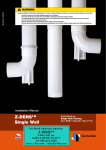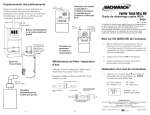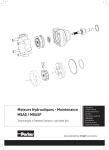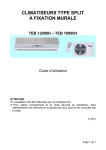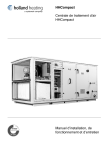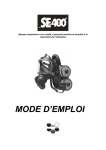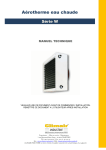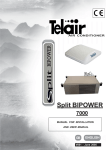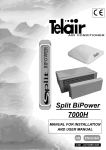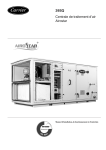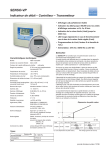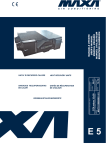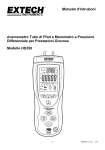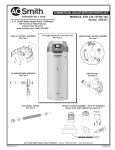Download Z-DENS™ Flex
Transcript
BK-CG-102 • 891153 WARNING Improper installation of Vent System and Components, or failure to follow installation instructions, can result in property damage or serious injury. - Examine all components for possible shipping damage prior to installation; Proper joint construction is essential for a safe installation. Follow these instructions exactly as written; This venting system must be free to expand and contract. This venting system must be supported in accordance with these instructions; Check for proper joint when joining pipe to fittings; Check for unrestricted vent movement through, walls, ceilings, and roof penetrations; Different manufacturers have different joint systems and adhesives. Do not mix pipe, fittings or joining methods from different manufacturers Installation Manual Z-DENS™ Flex Single Wall Venting ULC-S636 / Class IIC- Max.110°C Installation Manual CoxDENS® PPs Flex CONTENTS Introduction 3 Installation Requirements 3 Approvals/Codes 3 Product specifications 3 CoxDENS PPs Flex Components ® General installation conditions 3 3 Installation of the CoxDENS PPs Flex system through a masonry chimney 5 Condensing solutions 8 Wall plates 8 Installation Details 9 ® Pull-in tool Coupling and inspection piece Chimney cover 9 9 Dealing with Condensate 10 11 Maintenance 12 2 10-1-2013 INTRODUCTION Product specifications • Single wall CoxDENS® PPs Flex is third party certified to ULC-S636 Flexible Vent pipes made of flame retardant Polypropylene material (certified for use flue gas in accordance with a standard for Class IIC rating (exhaust temperatures up to 110°C European standard DIN EN14471). Not UV resistant; (230°F)) and CE EN 14471. Certified diameters are 60mm (2”), • Sealings are made of Viton; 80mm (3”), 110mm (4”). The following installation instructions are • Supports of galvanized steel; in accordance with the requirements of section 4 of the ULC-S636 • Cox Geelen Pipe lubricant Chloride free; Standard. • System diameters: 60mm (2”), 80mm (3”), 110mm (4”); • Shaftcover: Single wall CoxDENS® PPs Flex is a vent system for type BH Gas-Venting, for use with ANSI Category II and IV gas burning appliances (condensing boilers) with a max flue gas temperature of 110°C. -Cover house is made from HDPE in the colour RAL9005 (Black) -Termination pipe is made from UV-stabilized Polypropylene material; -Gasket is made of EPDM in the colour RAL9005 (Black); In addition, please refer to the appliance manufacturer’s -Birdmesh made of stainless steel; instructions for restrictions to the total vent length or height, number of elbows that can be used, sizing of the vent or specifics COXDENS® PPs FLEX COMPONENTS as to appliance connections before proceeding with the installation take precedence over this document. For a list of ULC-S636 approved CoxDENS® PPs Flex components, please consult the CoxDENS® PPs Flex catalogue at www.coxgeelen.com. INSTALLATION REQUIREMENTS General installation conditions of this product. Appliance manufacturer’s installation instructions Installation and Annual servicing of the CoxDENS® PPs Flex vent system must be performed by a qualified installer, service contractor 1. Do not install CoxDENS® PPs Flex in areas where ambient air temperature exceeds 150°C (302°F). or gas supplier. The safe operation of a system is based on the use of parts supplied by the manufacturer and the performance of the 2. Do not store the CoxDENS® PPs Flex system in a system may be affected if the combination of these parts is not corrosive environment and keep protected from UV light used in the actual building construction. Acceptance of the system (ideally in its packaging). is dependent upon full compliance with the installation instructions. 3. The maximum continuous vertical vent length is 30m (98’). Always refer to the manufacturer’s instruction for appliance specific vent limitations. Approvals/Codes The installation has to conform to all relevant local, State, Provincial 4. The maximum allowable deflection (bend) of the flexible or National codes. Single wall CoxDENS PPs Flex venting system is vent is 45°, so that condensate does not collect in the approved for use under ULC-S636 Class II-C gas-fired appliances corrugations of the flexible vent. Since the flexible vents with a maximum flue gas temperature of 110°C (230°F). Cox Geelen can not be used in a complete horizontal position, the guarantees Single wall CoxDENS® PPs Flex up to a maximum flue connection between the appliance and the flexible vent gas temperature of 120°C (248°F). must be done by Cox Geelen rigid vent system. Follow ® the specific instructions that are supplied with rigid vent All penetrations of fire rated walls, floors, and ceilings must comply system. with national and local building codes and regulations, and be approved by the local regulatory authority and/or building inspectors. 5. CoxDENS® PPs Flex system expand and contract slightly during heating cycles. This vent system has to be supported in accordance with these instructions. 10-1-2013 3 6. Appliances can be operated immediately upon the completion of the CoxDENS® PPs Flex Vent System installation. 7. The vent pipe of CoxDENS® PPs Flex is rated to a maximum of 5000Pa (0.725psi) or 20” of water column. 8. The maximum flue gas temperature for CoxDENS® PPs Flex is 110°C (230°F) for ULC-S636 compliant installations. Cox Geelen guarantees CoxDENS® PPs Flex up to a maximum flue gas temperature of 120°C (248°F). 9. Cox Geelen Pipe lubricant (art.no. 0005CA000), especially made for the assembly of exhaust pipes in plumbing and heating systems. May be applied to all gaskets for ease of assembly. Don’t use another Pipe lubricant. 10. The minimum clearance to combustibles materials is zero, 0mm (0”). 11. Unless approved by the appliance manufacturer, only one appliance may be attached to the vent system. 12. Do not use CoxDENS® PPs Flex with any other manufacturer’s vent components. Cox Geelen CoxDENS® PPs Flex components must be used exclusively throughout the entire vent system. 4 10-1-2013 INSTALLATION OF THE COXDENS® PPs FLEX SYSTEM THROUGH A MASONRY CHIMNEY q at the bottom of the chimney SUPPORT Overview CoxDENS® PPs Flex ‹—› ÚÐÐ w on the roof • Mount the chimney bottom bend support in the chimney opening by pushing the spigot pin of the support plate into the 12 mm ∅ drilled hole. • Install the support horizontally and rest the front on the chimney wall. PULL-IN TOOL FOR FLEX • Connect the ‘pull-in tool’ to the end of the flexible pipe, to enable insertion by pulling down the chimney. See installation detail 2, page 9. sÐ ‹—› ÚÐÐ e PPs COUPLING TO JOIN FLEX-FLEX rÐ ‹—› ÚÐ eÐ r BRACING BRACKET FLEX yÐ max. 2 m ‹—› ÚÐÐ t uÐ iÐ • A centralising bracing bracket needs to be fitted to the flexible pipe at 2 meter spacing. • Arrange brackets inverted on flexible pipe so as to ease passage down chimney and fix each bracket with a cable tie. • At any point where the chimney is staggered, fit one bracing bracket before and one after the step. CHIMNEY ‹—› ÚÐÐ y • When necessary, it is possible to extend the flexible pipe by joining additional lengths using couplings. See installation detail 3, page 9. • An inspection piece can also be added. • Insert the pipe with the necessary bracing brackets into the chimney. • Do not grate the flexible pipe on sharp edges. • When the outside temperature is below 5° C the flexible pipe needs to be warmed up before installation. PPs FLEXIBLE PIPE qÐ f dÐ ‹—› ÚÐÐ • Feed the rope down chimney and then whilst feeding in the flex from the top, carefully pull down the flexible pipe from the bottom chimney opening. Make sure that sufficient space remains between the flexible pipe and the support plate in order to allow fitting of the bottom chimney bend. Also ensure to leave a min of 200 mm of flex pipe protruding at the chimney top. • Detach the pull-in tool, once again exposing the corrugated flex pipe end. 10-1-2013 5 Installation Manual CoxDENS® PPs Flex PPs FLEX-LOWER CHIMNEY BEND ADAPTER ‹—› ÚÐÐ i • A locking clamp is required at the FlexRigid vent joint. Slide the locking clamp over the male-end of the chimney bend connector with the hook facing the joint. Smear some of the enclosed lubricant (acid free) on the o/d of the flex end connector. The installation of the separate sections will be connected by pushing the male-end together with the female-end and snap the hook over the gasket bead to secure the two vent parts together. ma x .4 5° CHIMNEY TOP PROTRUSION OF FLEXIBLE PIPE ‹—› ÚÐ s • Fit the bottom chimney bend on the support. Make sure that the bend is positioned centrally in the chimney. INSERT SOCKET ADAPTER ‹—› ÚÐÐ a • Fit the chimney bend connector to the now open end of the flexible pipe. PPs CHIMNEY BEND ‹—› ÚÐ o ATTENTION • Make sure that approx. 200 mm of the flexible pipe protrudes at the top of the chimney. • Saw off excess flexible pipe leaving the correct length. Use a hand saw, cut in a groove to keep cut square. Remove the burr. FITTING CHIMNEY COVER TO FLEXIBLE PIPE ‹—› ÚÐÐ max. 30 m u • Please see expanded installation detail 11, page 10, for the installation of the chimney cover. In accordance with regulations, we must advise that you ensure the ATTENTION Never use screws or adhesives for connections of this system. System is designed for use with clamps as stated above only. inner dimension of the chimney does not exceed twice the diameter of the flexible pipe (maximum 2x), in order to avoid formation of a u-bend or air lock. 6 10-1-2013 d WALL PLATE • Fix the wall plate against the chimney opening. ‹—› ÚÐÐ f PPs PIPE ‹—› ÚÐÐ • Smear some of the enclosed lubricant onto the o/d of the protruding male connection from the bottom chimney bend then push it into the lip-sealed female socket end of the rigid PPs pipe. • Saw the rigid PPs pipe flush with the wall plate by using a handsaw. • Now it is possible to connect the concentric pipe from the boiler, • And finally mount the identification plate. Terminations must be in accordance with the appliance manufacturer’s instructions, local building code requirements, CAN/CSA-B149.1 and CAN/CSA-B149.2 CAUTION Damage to the gasket can result in the dangerous release of carbon monoxide! 10-1-2013 7 CONDENSING SOLUTIONS q Flat roof termination e w Wall termination r e Flex vent termination t w r Rigid vent termination t Pitched roof termination q WALL PLATES Wallplate B3 • Concentric B3 Wallplate C9_x Flue outlet/air inlet have a • concentric connection but flue pipe and concentric from the chimney only passes from the chimney shaft shaft. through the wall plate. The outer • pipe is blanked off to the chimney shaft. C9_x • The combustion air is being taken Flue pipe is completely surrounded by air and therefore fully protected. • Flue pipe is surrounded by air and therefore largely protected. • Flue outlet/air inlet are balanced Combustion air is being taken from the ventilated chimney shaft. • Concentric connection to the heating appliance. from the installation room via slots in plate outer pipe. • Concentric connection to the heating appliance. Single wall Wallplate B2 B2 • Flue gas outlet only passes from the chimney shaft through the wall plate. • Flue pipe is not surrounded by air. • The combustion air is being taken from the installation room (separate connection to the heating appliance). • 8 10-1-2013 Single pipe wall connection to the heating appliance. Installation Manual CoxDENS® PPs Flex INSTALLATION DETAILS INSTALLATION DETAILS Pull-in tool Coupling and Inspection piece Squeeze pipe end to accept oval shaped plate q into a groove of the flexible pipe w. Pull the cord e in order to get the adapter r over the flexible pipe end. Make sure that the adapter r completely covers the pipe end. Fix the pull-in tool cord t to the loop on the rope e. Click the mounting ring q in the 3th groove of the flexible pipe. Fit the gasket w in the upper groove. Put some lubricant r on the gasket w.Then click the coupling e on the mounting ring q. Ð ATTENTION Please watch the installation direction. The arrow on the product indicates the flue direction! t ——# ——@ r e r e w q Ð w q 10-1-2013 9 Installation Manual CoxDENS® PPs Flex INSTALLATION DETAILS Chimney Cover Feed the end of the flexible pipe w through the base piece of the cover assembly. Mount the base q of the chimney cover with screws to the top of the chimney. When using DN 60 and 80 always insert the appropriate reduction ring e into the top of the base. Click the mounting ring r in the 3th groove of the flexible pipe. Fit the gasket t in the upper groove. Put some lubricant d on the gasket t. Attach the outlet pipe y. Connect the synthetic wire u to join the base part to the cap of the chimney cover. Click the sealing ring o in the cap a of the chimney cover. Slide this cap over the end of the outlet pipe y. Press and click the cap onto the base q. Finally a wire-form terminal guard s can be fitted in the cap aperture. s d ——z! o a y t u t y r e r w i q 10 10-1-2013 DEALING WITH CONDENSATE into the boiler room and equally to prevent back flow of fumes from the sewer discharge point. Always read the Appliance manufacturers installation instructions in To avoid condensate freezing and disruption of normal operation conjunction with those from Cox Geelen. of the appliance the condensate evacuation pipe routing should be If the appliance manufacturers installation instructions state that suitably arranged internally wherever possible. condensate cannot be discharged through the boiler appliance Exposure of condensate collection and discharge pipe work to then the flue gas condensate must not be allowed to flow back to extreme temperatures and UV light should be avoided at all times. the boiler. This can be achieved by fitting the condensate trap and Condensate removal and disposal must conform to NEN 3287 and drain component into the CoxDENS PPs flue system. NEN 3215 All components within this condensate collection and Regardless of boiler appliance flue system installation mode - discharge system should be manufactured in condensate resistant Vertically or Horizontally - the condensate trap and drain can be materials- this can be assured by use of the Cox Geelen siphon and fitted - see diagrams below. The condensate trap’s drain off pipe drain pipe (part no 0004.CA.000). must be connected to a condensate resistant tube of minimum The condensate removal components, siphon and discharge pipe internal diameter ¾”, then via a siphon/ airlock controlled outflow work must be to a secured “open” connection to the sewer drain or neutralising qualified appliance service engineers ideally at the annual service system. An appropriately sized siphon/airlock MUST be fitted to of the appliance. ® inspected and maintained annually by suitably maintain room sealed conditions, preventing flue gas emissions Vertical connection Connection to drain Horizontal connection q Drain w CoxDENS® PPs vent system e Condensation drain r Appliance t Drainage - canal 10-1-2013 11 Installation Manual CoxDENS® PPs Flex MAINTENANCE Cox Geelen recommends that gas appliances using CoxDENS® PPs Flex venting should be checked once a year by a qualified installer. These Recommendations were issued on 10-1-2013 by: Cox Geelen Emmastraat 92 • 6245 HZ Eijsden • PO-Box 6 • 6245 ZG Eijsden • The Netherlands T +31 (0)43 40 99 500 • F +31 (0)43 40 91 987 • [email protected] • www.coxgeelen.com Chamber of Commerce Limburg 14608324 12 10-1-2013 BK-CG-102 • 891153 AVERTISSEMENT Une mauvaise installation du système d’évacuation et de ses composants, ou une mauvaise interprétation des instructions de montage, peuvent entraîner des dommages matériels ou des blessures graves. - Avant le montage, examiner toutes les pièces pour s’assurer qu’elles n’ont pas subi de dommage pendant le transport. Une installation est sans danger essentiellement si les conduits sont correctement assemblés. Suivre ces instructions à la lettre. Les conduits d’entrée d’air et de sortie de gaz de combustion doivent être libres de se dilater et se contracter, et pour cela ils doivent être fixés selon ces instructions. Lors de l’assemblage ; veiller à ce que tous les éléments du conduit soient bien ajustés. Vérifier que le flux d’évacuation ne soit pas entravé dans les passages des murs, plafond, et toit. Les systèmes de raccordement et de fixation diffèrent selon les fabricants, en conséquence ne surtout pas mélanger conduits, systèmes de fixation ou de raccordement de fabricants différents. Manuel d’Installation Le Conduit simple ULC-S636 / Class IIC- Max.110°C Manuel d’installation CoxDENS® PPs Flex TABLE DES MATIÈRES Introduction 3 Conditions d’installation 3 Homologations/règlements 3 Spécifications produits 3 Composés CoxDENS PPs Flex ® Conditions générales d’installation 3 3 Installation vertical flexible, à travers la cheminée maçonnée 5 Configurations pour chaudière à condensation 8 Plaques murales 8 Détails d’installation 9 Outil de halage Adapteur flex-flex et d’inspection Terminal Cheminée 9 9 Condensats 10 11 Maintenance 12 2 10-1-2013 INTRODUCTION Spécifications Produits • Le Conduit simple CoxDENS® PPs Flex est certifié par un Conduit des fumées avec retardant de flamme en Polypropylène (homologué en conformité avec la norme organisme indépendant à la norme ULC-S636 standard pour européenne DIN EN 14471); Classe IIC (température maximale des gaz de combustion 110°C • Joints en Viton; (230°F) et CE EN 14471. Diamètres certifiés : 60mm (2”), 80mm • Support en acier galvanisé; (3”) et 110mm (4”). Les instructions d’installation suivantes sont • Lubrifiant sans chlorure CoxGeelen pour l’emboitage des conformes avec les critères de la section 4 de la norme ULC-S636. CoxDENS® PPs Flex est un système d’évacuation de type Gas-Vent-BH, pour ANSI de classe II et IV à gaz (chaudières à condensation) avec des gaz brulés à une température maximale de 110°C. conduits; • Diamètres des conduits: 60mm (2”), 80mm (3”), 110mm (4”); • Chapeau de cheminée: - Le chapeau de cheminée est en HDPE (RAL9005) (noir) ; - Le conduit terminal est en Polypropylène résistant aux UV ; Se conformer impérativement aux instructions du fabricant de la - Le joint est en EPDM de couleur RAL9005 (noir) ; chaudière à propos des limitations concernant les conduits : - La grille de protection est en acier inoxydable; • Diamètre • Hauteur • Longueur • Nombre de coudes COMPOSÉS COXDENS® PPs FLEX Pour consulter la liste des homologations ULC-S636 des composants CoxDENS® PPs Flex veuillez consulter le catalogue sur le site www.coxgeelen.com. CONDITIONS D’INSTALLATION L’installation et l’entretien annuel du système CoxDENS® PPs Flex doit être effectué par un installateur qualifié, une société de maintenance Conditions generales d’installation ou un fournisseur de gaz. L’utilisation des pièces fournies par le fabricant garantit un fonctionnement sans risque et la performance du système pourrait 1. Ne pas installer CoxDENS® PPs Flex dans des zones où la température ambiante excède 150° (302°F). être affectée si les conduits n’étaient pas correctement assemblés. L’acceptation du système repose entièrement sur sa totale conformité 2. Stocker les éléments CoxDENS® PPs Flex dans un environnement NON-corrosif et à l’abri des UV avec les instructions d’installation. (idéalement dans son emballage) 3. La distance maximum verticalement est 30m (98’). A Homologations/Règlements propos des conduits, se référer impérativement aux L’installation doit être conforme à tout règlement local, Provincial et instructions du fabricant de la chaudière pour la hauteur National. Le système de conduits de fumée CoxDENS® PPs Flex est maximale tolérée. homologué sous le n° ULC-S636 de la Classe II-C des chaudières à gaz pour une température maximum de 110° (230°F) dans ses 4. Pour une gaine flexible, la courbure maximale (coude) PPs Flex pour une autorisée est de 45° pour éviter que le condensat ne conduits. Cox Geelen guarantit CoxDENS ® chaleur maximum de 120° (248°F) dans ses conduits. s’accumule dans les ondulations du flexible. Etant donné que les conduits flexibles ne doivent pas être installés La protection incendie des murs, planchers et plafonds doit répondre à horizontale, le conduit reliant la chaudière au flexible aux normes nationales, aux règlements de copropriétés des doit être en Cox Geelen rigide. Suivez les instructions immeubles et être approuvée par les autorités légales concernées. spécifiques fournis avec le système de ventilation rigide. 5. Les conduits CoxDENS® PPs Flex sont amenés à se dilater et se contracter. Le système de conduits doit être fixé à l’aide des supports selon les instructions. 10-1-2013 3 6. La chaudière peut fonctionner immédiatement après l’installation des conduits CoxDENS® PPs Flex. 7. Le conduit intérieur CoxDENS® PPs Flex est conçu pour une pression maximale de 5000Pa (0.725psi) ou une colonne d’eau de 20’’. 8. D’après la norme européenne ULC-S636, la température du gaz autorisée pour les conduits CoxDENS® PPs Flex est de 110° (230°F) maximum. CoxGeelen garantit ses conduits CoxDENS® PPs Flex pour une température maximale de 120° (248°F). 9. Le lubrifiant Cox Geelen (art.n° 0005CA000) a été fabriqué spécialement pour assembler les conduits dans les installations de plomberie et chauffage. Ne pas utiliser un autre lubrifiant. 10. La distance minimum de matériaux inflammables est 0 mm (0’’). 11. Une seule chaudière doit être raccordée au système de conduits, sauf indication contraire du fabricant de chaudière. 12. Ne jamais utiliser les composants CoxDENS® PPs Flex avec des composants de fabrication différente. 4 10-1-2013 Manuel d’installation CoxDENS® PPs Flex INSTALLATION COXDENS® PPs FLEX, À TRAVERS LA CHEMINÉE MAÇONNÉE q ‹—› ÚÐÐ • Installer horizontalement le support métallique de coude à la base du conduit de cheminée en introduisant l’ergot dans un trou ∅ 12 mm à percer sur la paroi du fond du conduit et en posant l’autre extrémité sur le rebord de l’ouverture de la face avant. OUTIL DE HALAGE sÐ ‹—› ÚÐÐ e en bas de la cheminée SUPPORT CoxDENS® PPs Flex w sur le toit • Fixer l’outil de halage à une extrémité du flexible pour permettre de tirer le flexible de haut en bas dans le conduit de cheminée. Voir le détail d’installation 2, page 9. ADAPTEUR FLEX-FLEX rÐ • Il est possible de rallonger le flexible en utilisant l’adaptateur flex-flex. Voir le détail d’installation 3, page 9. • Un T de visite peut également être ajouté. ‹—› ÚÐ eÐ r ÉTOILE DE CENTRAGE yÐ max. 2 m ‹—› ÚÐÐ t uÐ iÐ CONDUIT DE CHEMINÉE ‹—› ÚÐÐ y • Poser une étoile de centrage tout les 2 mètres sur le flexible, pointes vers le haut pour faciliter l’insertion dans le conduit. • Fixer chaque étoile avec la bride [fournie]. • Fixer une étoile avant et après chaque coude du conduit. • Insérer le flexible équipé de ses étoiles de centrage dans le conduit de cheminée en évitant de l’érafler sur les aspérités du conduit. • Lorsque la température extérieure est en dessous 5° C, réchauffer le flexible avant de le poser. FLEXIBLE PPs qÐ f dÐ ‹—› ÚÐÐ • Faire descendre la corde de rappel dans le conduit de cheminée puis haler précautionneusement le flexible et ses étoiles. S’assurer qu’il reste un espace suffisant pour la pose du coude et laisser un minimum de 200 mm de flexible dépasser du haut du conduit de cheminée. • Détacher l’outil de halage du flexible. 10-1-2013 5 Manuel d’installation CoxDENS® PPs Flex u ADAPTATEUR FLEX-COUDE ‹—› ÚÐÐ i • Poser le coude sur son support. S’assurer que le coude soit au centre du conduit de cheminée. ADAPTATEUR FLEX-COUDE ‹—› ÚÐÐ a • Fixer l’adaptateur sur l’extrémité inférieure du flexible. COUDE BASE CONDUIT CHEMINÉE ‹—› ÚÐ o ATTENTION • Un onglet de fixation doit être monté à chaque jointure. Glisser le l’onglet sur la terminaison mâle du conduit avec l’ergot face au joint. Enduire l’embout de l’adaptateur de lubrifiant non acide (lubrifiant fourni). Assembler les segments de conduit en introduisant une terminaison mâle dans une terminaison femelle puis faire glisser l’ergot par-dessus le joint et le cliquer pour verrouiller la jonction des deux segments. ma x .4 5° DÉPASSEMENT FLEXIBLE HAUT CHEMINÉE • Couper droit dans une rainure l’excédent de flexible en laissant dépasser une longueur de 200 mm ; • ébarber. ‹—› ÚÐ FIXATION CHAPEAU DE CHEMINÉE max. 30 m s • Voir le détail d’installation 11, page 10. ‹—› ÚÐÐ Afin d’éviter la formation de siphon, nous vous conseillons, ATTENTION Ne jamais utiliser de vis ou d’adhésif pour maintenir les connexions, car ce système est conçu pour être utilisé uniquement avec des colliers de serrage comme indiqué ci-dessus! en plus des diverses règlementations, que la dimension interne du conduit de cheminée ait un diamètre de maximum 2x celle du conduit. 6 10-1-2013 d PLAQUE MURALE CHEMINÉE • Fixer la plaque sur l’entrée de la cheminée. ‹—› ÚÐÐ f CONDUIT PPs RIGIDE ‹—› ÚÐÐ • Lubrifier l’embout mâle du coude et y connecter l’embout femelle d’un conduit PPs rigide. • Scier le conduit rigide à ras de la plaque murale. • Maintenant connecter le conduit de la chaudière. • Enfin, poser la plaque d’identification. Les terminaux doivent être en conformité avec les instructions du fabricant de Chaudière, et les règlements de l’immeuble concerné, CAN/CSA-B149.1 and CAN/CSA-B149.2 ATTENTION Un joint endommagé peut entrainer des fuites dangereuses de monoxyde de carbone! 10-1-2013 7 CONFIGURATIONS POUR CHAUDIÈRE À CONDENSATION q Terminal toit plat e w Terminal mural r e Terminal flexible t w r Terminal rigide t Terminal toit en pente q PLAQUES MURALES Caractéristiques plaque murale B3: • La sortie d’évacuation/entrée d’air a Concentrique B3 • Le conduit de fumée passe dans une connexion concentrique mais le conduit de cheminée à travers la le conduit de fumée uniquement plaque murale. sort du conduit de cheminée à travers la plaque murale. Le conduit extérieur est obturé par le conduit de C9_x Caractéristiques plaque murale B2: cheminée. • Le conduit de fumée est entouré d’air • L’air de combustion est pris dans la pièce de l’installation (connexion séparée de la chaudière). • Conduit mural unique connecté à la chaudière. et est donc largement protégé. • L’air de combustion est pris Conduit simple B2 Caractéristiques plaque murale C9_X: dans la pièce de l’installation par • Les sorties d’évacuation/entrée d’air l’intermédiaire de fentes dans la sont équilibrées et concentriques à plaque du tuyau extérieur. partir du conduit de cheminée. • Connexion concentrique à la chaudière. • Le conduit de fumée est entouré d’air et il est donc complètement protégé. • L’air de combustion est pris depuis le conduit ventilé de la cheminée (le ventile le conduit de cheminée). • Connexion concentrique à la chaudière. • La connexion de cheminée la plus sûre. 8 10-1-2013 Manuel d’installation CoxDENS® PPs Flex DÉTAILS D’INSTALLATION DÉTAILS D’INSTALLATION Outil de halage Adaptateur flex-flex et d’inspection Presser conduit au dessous ovale. Monter la plaque q dans une rainure du conduit flexible w. Tirer sur la corde e afin d’avoir la tête de l’outil de halage r recouvre le bout du flexible. Fixer le mousqueton de la corde de halage t sur l’anneau de l’outil de halage e. Positionner la bague de fixation q dans la 3ème rainure du flexible. Insérer le joint w dans le premier sillon du flexible. Mettez un peu de lubrifiant r sur le joint w. Enfin clipser les deux e embouts de l’adaptateur q. ATTENTION Respecter le sens de l’installation. Une flèche sur le pieces indique le sens des fumes!! Ð t ——# ——@ r e r e w q Ð w q 10-1-2013 9 Manuel d’installation CoxDENS® PPs Flex DÉTAILS D’INSTALLATION Terminal cheminée Enfiler le bout du flexible w dans la base du terminal. Visser la base q sur le dessus du conduit de cheminée. Utiliser le réducteur approprié e avec le vis Ø60mm (Ø2”) et Ø80mm (Ø3”). Clipser l’anneau de fixation r dans la 3ème sillon du flexible. Mettre le joint concentrique t dans le premier sillon du flexible. Mettez en peu de lubrifiant d sur le joint t. Connecter le flexible y. Relier le fil nylon u à la base du couvercle de terminal. Clipser le joint concentrique o dans le couvercle a. Faire coulisser le couvercle jusqu’au bout du flexible y. Clipser le couvercle sur la base q. Enfin une grille de protection s peut être fixée sur l’ouverture du couvercle de cheminée. s d ——z! o a y t u t y r e r w i q 10 10-1-2013 CONDENSATS d’évacuation des eaux ou à un neutraliseur des condensats. Pour éviter un gel des condensats et un disfonctionnement de la Respecter les instructions du fabricant de chaudière de même que chaudière, le circuit d’évacuation des condensats doit être installé celles de Cox Geelen. à l’intérieur Si les instructions du fabricant de la chaudière spécifient que Les condensats ainsi que les déchets du tuyau d’évacuation ne les condensats ne doivent pas s’écouler dans la chaudière alors doivent pas être exposés à des températures extrêmes ni aux UV. le conduit de fumée ne doit pas refouler les condensats vers la La récupération et l’élimination des condensats doivent être chaudière. Le problème peut être résolu en montant un récupérateur conformes aux normes EN 3287 et EN 3215.Tous les éléments de condensats CoxDENS et son drain sur le système utilisés pour la récupération et l’élimination des condensats doivent Le récupérateur de condensats CoxDENS® et son drain peut être être fabriqués dans des matériaux résistants aux condensats monté sur un conduit horizontal ou vertical.– voir diagrammes ci- – ainsi que le sont le syphon et le drain flexible de Cox Geelen dessous. (part no 0004.CA.0-00). Le drain du récupérateur de condensats doit être raccordé à Le récupérateur de condensats, syphon et drain doivent être un tube résistant aux condensats de diamètre interne de 15mm inspectés et entretenus par des ingénieurs qualifiés lors de la minimum, lequel via un syphon avec sas est connecté à un circuit maintenance annuelle. ® Connection verticale Canal de drainage Connection horizontale q Conduit d’évacuation w CoxDENS® PPs Flex e Récuperateur de condensate r Chaudière t Canal de drainage 10-1-2013 11 Manuel d’installation CoxDENS® PPs Flex MAINTENANCE Cox Geelen recommande que les chaudières à gaz utilisant les conduits CoxDENS® PPs Flex doivent être vérifiés annuellement par un installateur qualifié. Recommendations éditées le 10-1-2013: Cox Geelen Emmastraat 92 • 6245 HZ Eijsden • PO-Box 6 • 6245 ZG Eijsden • The Netherlands T +31 (0)43 40 99 500 • F +31 (0)43 40 91 987 • [email protected] • www.coxgeelen.com Chamber of Commerce Limburg 14608324 12 10-1-2013
























